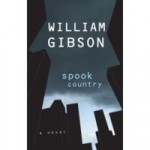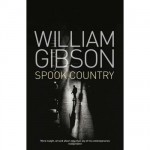 Spook Country is the place of no fixed boundary, where official governments and their shadowy minions mingle, betraying friends and arming future enemies. The Dick Cheneys of the world assure us that what they do there is all for our own good and that we should sleep better at night for it, but we suspect that more than a little of what comes of it feathers their own beds. And more and more we know they really don’t have a clue.
Spook Country is the place of no fixed boundary, where official governments and their shadowy minions mingle, betraying friends and arming future enemies. The Dick Cheneys of the world assure us that what they do there is all for our own good and that we should sleep better at night for it, but we suspect that more than a little of what comes of it feathers their own beds. And more and more we know they really don’t have a clue.
In the age of post-9/11 neo-surveillance, counter-terrorism is the new terrorism, and every cultural production, be it furniture, appliance, weapon, art work, act of Congress or staged event such as political rally or act of terror, is authentic only if it is inauthentic; if, in other words, it is, as William Gibson suggests, “a very elaborate artifact, mass-produced by artisans of one culture in vague imitation of what had once been the culture of another.â€
And what is the most primitive human artifact still in use? The container: bag, box, pocket, backpack, diplomatic pouch, car bomb, micro-chip, cargo container.
You may not know what it is, or what it contains, but in Gibson’s latest novel, Spook Country, now in paperback (Berkley Trade, $15.00), Bobby Chombo can tell you where in our undifferentiated global grid it is right this minute. Chombo is geek squad gone over the edge. His GPS grid-induced paranoia leads him to divide his warehouse into squares and he never sleeps twice in the same spot. Trained in militarily valuable applications of Global Positioning, he now freelances for conceptual artists like Alberto Corrales, for whom he triangulates complicated bits of computer-simulated reality on location. Slip on a custom helmet and you see a life-like hologram of River Phoenix dead on the street or pale F. Scott Fitzgerald dying in a bar. Corrales’ latest piece involves Charlie Manson and Sharon Tate.
But Chombo also works for an unnamed old man, seasoned, avuncular, who may be a rogue CIA operative, and who appears to bear the scars of betrayal from as far back as the Bay of Pigs. The old man has Chombo tracking a cargo container bound for North America.
What’s in the container? Perhaps it’s smuggled arms, or a weapon of mass destruction, or human cargo, or a huge chunk of small bills the U.S. shipped to Iraq and then lost. Or perhaps it’s simply an al-Qaida dry run to test Homeland Security. Or perhaps container and cargo are another virtual creation, an element of the “consensual hallucination,†as Gibson calls the internet.
 And these are the minor characters among the rich cast in Spook Country. As in Gibson’s last novel, Pattern Recognitions, the absorbing consciousness is a female, in this instance Hollis Henry, a journalist and former member of an indie rock group with a small but fervent cult following, who has been hired to write a story about Corrales’ Locative Art movement. Her magazine, Node (a European version of Wired), is the brainchild of Hubertus Bigend, a character from Pattern Recognitions. Node, in fact, may not be a magazine at all, but instead another front project for Bigend, a rogue financier with interests, economic and personal, that he pursues in a highly idiosyncratic style. Bigend is rich in the high-end fashion that signals money as a “universal solvent,†exempting those who have it from all strictures, for good or bad. Bigend is out to satisfy his curiosity, and his “data mining†activities have led him to Chombo’s strange signals.
And these are the minor characters among the rich cast in Spook Country. As in Gibson’s last novel, Pattern Recognitions, the absorbing consciousness is a female, in this instance Hollis Henry, a journalist and former member of an indie rock group with a small but fervent cult following, who has been hired to write a story about Corrales’ Locative Art movement. Her magazine, Node (a European version of Wired), is the brainchild of Hubertus Bigend, a character from Pattern Recognitions. Node, in fact, may not be a magazine at all, but instead another front project for Bigend, a rogue financier with interests, economic and personal, that he pursues in a highly idiosyncratic style. Bigend is rich in the high-end fashion that signals money as a “universal solvent,†exempting those who have it from all strictures, for good or bad. Bigend is out to satisfy his curiosity, and his “data mining†activities have led him to Chombo’s strange signals.
Bigend is interesting, smart, even when his enigmatic philosophy comes out half homily. His dark, droll assessment of computers is that the most interesting applications of new technology show up on the battlefield or in art galleries. He says that secrets and intelligence gathering are “advertising turned inside out.†He is after “secrets,†not to manipulate them but to hold and appreciate them – the subliminal message is the massage. His ruling metaphor is standardization, the ubiquitous containers full of merchandise or contraband or even human cargo in contrast to “breakbulk†cargo, open shipments of crates and bags and things stacked chock-a-block. In his terms: “Traditional human intelligence. Someone knowing something. As opposed to data mining.â€
Other minor characters are chiseled quickly but neatly. Tito, of the new illegal immigrant class, is a member of a tight-knit Chinese-Cuban family performing specialized carrier work for any entity willing to pay enough. Tito is anonymous and virtually invisible on the street, holding “the keys to some special kind of subway-based porosity, a way into the cracks and holes and spaces between things.†As tightly wrapped as he is diminutive, Tito has the ability to disappear and begin again in a new city. “The ritual disassembly, this meticulous scrubbing out of traces, erasure. As Juana would say, the washing of the threshold of the new road.â€
Finally, there’s Brown, a right-wing thug, who works either for the government or for one of the private armies that work for the government but not exactly to do government work, and the junkie Milgrim, Brown’s willing-captive translator.
Hollis knows Bigend is using her, but she has her own reasons for being curious, so lets herself be drawn into the converging threads of plot that lead from L.A., New York and Washington, D.C. to Vancouver, B.C. Again, Hollis is the absorbing consciousness, all loose ends lead eventually to her. She embodies the angst, the emotional center that is the “unwobbling pivot†in each of Gibson’s novels. It is the angst that is not quite paranoia. It is the angst that puts on the face of romantic individualism, the angst that sends his heroes veering from the grim fate that the chaotic world holds, whether in the “Sprawl,†that virtual 82nd Avenue stretching from Boston to Atlanta and fading into the Appalachia (the trilogy Neuromancer, Count Zero and Mona Lisa Overdrive), or the Bay Bridge, that future shanty town towering and teetering over Berkeley and San Francisco (the trilogy Virtual Light, Idoru and All Tomorrow’s Parties), or the world of the present that Gibson explores in his latest novels.
 Spook Country is a relentless, seductive thriller, with surprising twists in plot and disorienting strangeness, intellectual pleasures that are the hallmark of Gibson’s writing. It may seem strange to emphasize that Gibson’s writing is highly literary and consistently underrated because it’s perceived as science fiction, and a merely revisionist “cyberpunk†version at that. But his strange, hip invocation of the future – genetic engineering and chemical manipulation, the globalized world of the internet and capitalist domination – has always been about metaphor. Which is why his literary version of cyberspace is so much more vivid and exciting then the dull lame film versions such as The Matrix trilogy, or, and especially, the abortive efforts to translate his work into film (Johnny Mnemonic and New Rose Hotel). The film Blade Runner captures Gibson’s romantic spirit, and the spirit of his prose, more so, actually, than it does the prose of Philip K. Dick. (Which is not, please note, any criticism of Dick’s prose style or his novel that Blade Runner is based on, Do Androids Dream of Electric Sheep.)
Spook Country is a relentless, seductive thriller, with surprising twists in plot and disorienting strangeness, intellectual pleasures that are the hallmark of Gibson’s writing. It may seem strange to emphasize that Gibson’s writing is highly literary and consistently underrated because it’s perceived as science fiction, and a merely revisionist “cyberpunk†version at that. But his strange, hip invocation of the future – genetic engineering and chemical manipulation, the globalized world of the internet and capitalist domination – has always been about metaphor. Which is why his literary version of cyberspace is so much more vivid and exciting then the dull lame film versions such as The Matrix trilogy, or, and especially, the abortive efforts to translate his work into film (Johnny Mnemonic and New Rose Hotel). The film Blade Runner captures Gibson’s romantic spirit, and the spirit of his prose, more so, actually, than it does the prose of Philip K. Dick. (Which is not, please note, any criticism of Dick’s prose style or his novel that Blade Runner is based on, Do Androids Dream of Electric Sheep.)
Now Gibson has retrenched – the future is now. Corrales’ holograms are as close as we come to any of the cyberspace invention of Gibson’s earlier books. But the eerie magic is still there, the “spiritual vertigo†Marly experiences in Count Zero, feeling like she’s trembling “at the edge of some precipice.†Like the Joseph Cornell boxes Gibson describes in Count Zero, his books are “geometries of nameless longing.†Each of the eighty four chapters in Spook Country is a cargo container.
Some of the loose-end activities raise questions. Is it an overzealous Department of Homeland Security effort to stifle dissent? Is it a covert U.S. program to intercept smuggled weapons or a dirty bomb? Are these folks outsiders, realigning loyalties to fit current employment? Or perhaps they are rogue former agents with their own agenda counter to visible politics? What do we really know if everything in cyberspace is untraceable and subject to distortion and manipulation? Paranoia is knowledge turned inside out.
Spook Country is that place where the things of our paranoid fantasies actually do happen.
*Gibson image by Fred Armitage at Flickr.